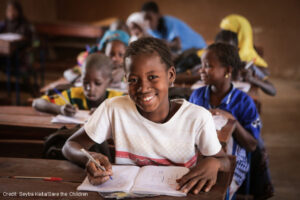
Aissata, aged 11, at school in Mopti region, Mali. She refuses to let the violence in her region destroy her hopes of a future. She decided to register for a school supported by Save the Children, and is making up for lost time. “I found that the others had already started classes. I worked hard, I persevered and overtook them. And I became top of the class.”
This blog was written by Anya Cowley, Education Adviser & Chiara Damen, International Advocacy and Policy Coordinator from Save the Children based in the UK and Italy.
Ahead of the Global Education Summit and the G20, leaders must deliver an ambitious education financing package – including pledges to Global Partnership for Education – to mitigate the impacts of COVID-19 school closures.
Last weekend, 11-13 June 2021, leaders from the world’s largest economies met in the UK to address some of the most pressing global challenges of our time. Following weeks of negotiations, leaders adopted the Girls’ Education Declaration in the Carbis Bay G7 Leaders’ Summit Communique, which includes two new global targets to get 40 million more girls in school and 20 million more reading by aged 10 by 2026.
However, the funding announcement fell far short of what is needed to deliver the targets and tackle the global learning crisis. As the world’s biggest aid donors, the collective G7 pledge of $2.7 billion to the Global Partnership for Education (GPE) simply does not reflect the severity of the learning crisis and the financing gap. Without sustainable funding to education, the new Declaration will remain an empty promise.
And the need has never been more urgent. Save the Children’s new analysis estimates that children in low-income countries have lost 66% more of their lifetime number of schooldays due to COVID-19 compared with their peers in richer countries. On average, girls in poorer countries missed 22% more of their total school lives than boys.
The Global Education Summit in July in London and the G20 Summit in October in Rome are two critical opportunities for world leaders – including the G7 – to put their money where their mouth is. They must deliver an ambitious financing package – including strong pledges to GPE – to get all children safely back to school and learning, including the 258 million children who were out of school even before the pandemic.
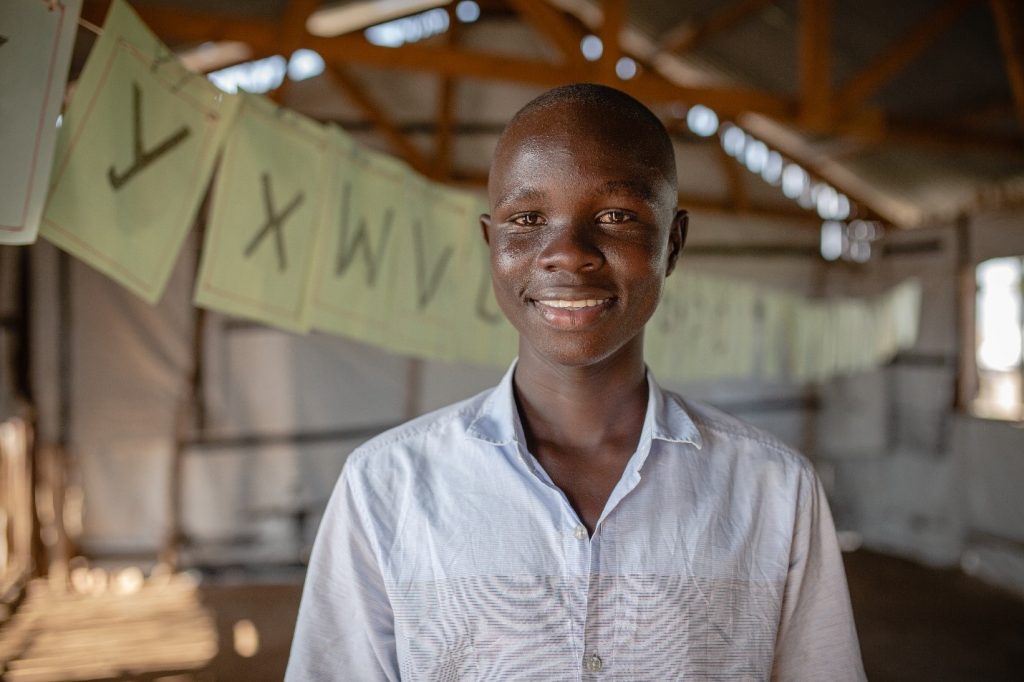
Jonathan, 15, a child campaigner who has also encouraged other children in his community to go back to school. He is a South Sudanese refugee living in Uganda, who has inspired other children in his community to go back to school. In November 2020, he spoke on behalf of children in Uganda to The Minister of State for Higher Education and lobbied for schools in Uganda to re-open for all classes.
Credit: Esther Ruth Mbabazi/Save the Children
The impacts of lost school days
Whilst leaders enjoyed sea shanties, buttered rum, and toasted marshmallows on the beach in Cornwall, millions of children living in the world’s toughest places continued to miss out on education.
According to our new analysis, children in low-income countries in the world have lost up to 20% of their lifetime days in school due to the COVID-19 pandemic – with conflict adding to school closures in some countries. The trend shows that the percentage of lifetime schooling lost for girls is generally greater than for boys. For instance, in Guinea, children have missed some 22% of their total lifetime of school days on average; boys lost an average of 15% of their lifetime schooldays, girls lost an astonishing 39%.
This new analysis is likely to be an underestimate, as the global data available does not capture all school days lost in partial school system closures. It also does not capture access to remote learning, which would likely widen the gap between wealthy and low-income countries.
School is not only a place to learn, but a place to make friends, eat a healthy meal, and feel safe. Being out of school can change the course of a girls’ life. Save the Children estimates a dramatic surge in child marriage due to the pandemic, which is expected to rise by an additional 2.5 million over five years.
Karina, 17, from South Sudan should be in eighth grade, but has been out of school due to the pandemic:
“The biggest concern is that girls who have not been attending school… their parents force the girls to get married. If they force you to marry, you will not get a better education. Your education will stop there.”
100 Days of Action
Children have spoken loud and clear. This month, as part of our global Save Our Education campaign we kicked off 100 Days of Action with partners to demonstrate the urgency of the education crisis and put pressure on all governments to fund education. In just the first week, 4,000 children around the world took action ahead of the G7 summit.
We are making progress towards the $5 billion GPE needs to enable 175 million to learn. Ahead of the G7, Italy made a strong pledge of EUR 25 million, of which half is dedicated to girls’ education in Africa, followed by the EU who announced EUR 700 million over seven years – the largest ever pledge to the GPE. But there is still more work to do.
The pledge by the UK of £430 million – whilst an increase of 15% on their previous pledge – still falls short of what is needed, as does the Canadian pledge of CAD $300 million. All donors must aim to increase their annual support to meet growing needs.
Education budgets are being hollowed out due to increased resource needs in response to school closures, and pressure on domestic finances. The estimated annual education financing gap in low- and lower- middle-income countries has risen by a third due to the impacts of COVID-19, from US$148 billion by up to an additional US$45 billion. This comes as aid to education is projected to decrease by 12% globally from 2018-2022. Whilst many countries pledged to make education core to their recovery plans in the GEM Declaration, many are unlikely to be able to mobilise the domestic finances needed to deliver children’s right to education without international support.
All G7 leaders must now invest in and account for the declaration
That is why where necessary, governments must top up their pledges ahead of the Global Education Summit in July. As co-host, the UK must demonstrate how this can be done. Harriet Baldwin MP’s blog charts a road map for how the UK could achieve this through match funding and a return to spending 0.7% of national income on international aid.
And to translate words into action, the G7 Girls’ Education Declaration must also be backed up by a comprehensive implementation plan and inclusive accountability mechanism that goes beyond the existing G7 accountability process. This should not just be limited to the global targets – but cover the full declaration – and be shared and honored across all G7 members.
Later in the year, the Summit of the G20 Heads of State and Government, is a further chance to get education back on track and protect a generation from the economic impacts of the pandemic. Putting education at the heart of recovery efforts must be central to discussions at the G20 Ministerial Meetings at the end of this month.
To do so, all G20 governments must:
- Protect and increase aid spending in line with global targets to spend 0.7% of GNI on aid, with progressive commitments towards 15% of ODA for education.
- Make bold and ambitious pledges to the GPE to ensure it is fully funded at $5 billion.
- Support the early replenishment of the World Bank’s International Development Association (IDA20), prioritising aid spending on social sectors and on children.
- Support debt cancellation, including extending the Debt Service Suspension Initiative at least until the end of 2022, devolving their recently released Special Drawing Rights quota to the poorest countries and moving towards an independent mechanism for the systematic, comprehensive, and enforceable treatment of unsustainable debt.
Whilst children have sacrificed their schooldays to keep adults safe during the pandemic, world leaders must act now to get learning back on track, build forward better education systems, and deliver on their promises to children.

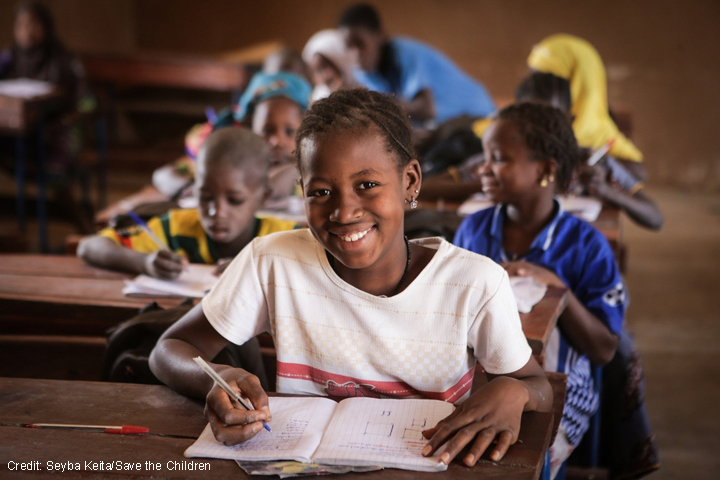
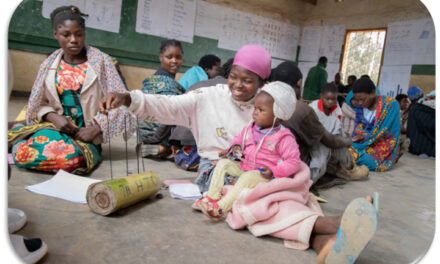
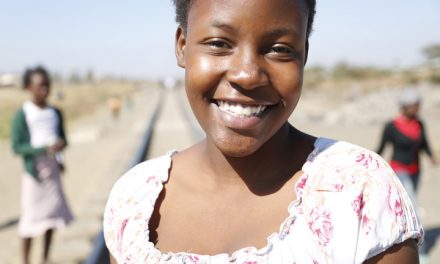
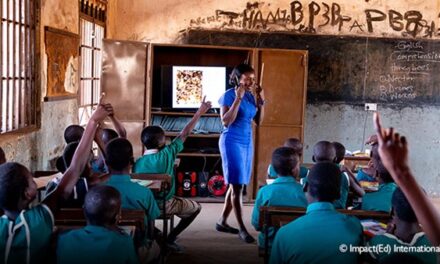
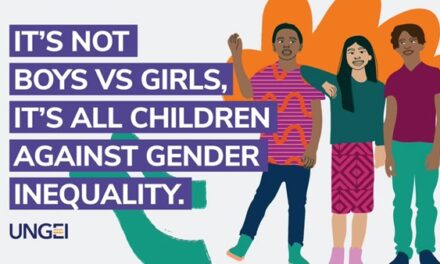
By taking education, children can also learn about leadership. Hopefully this pandemic will end soon, so that children can gain knowledge without limits